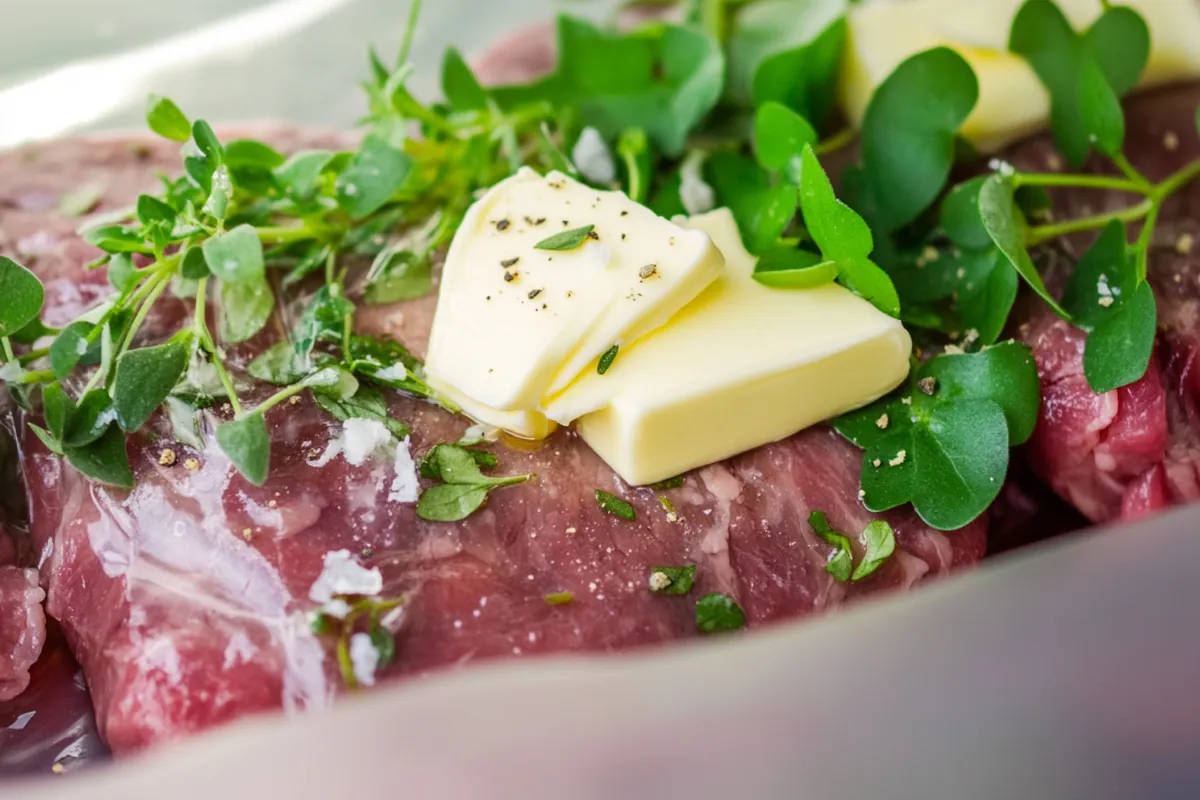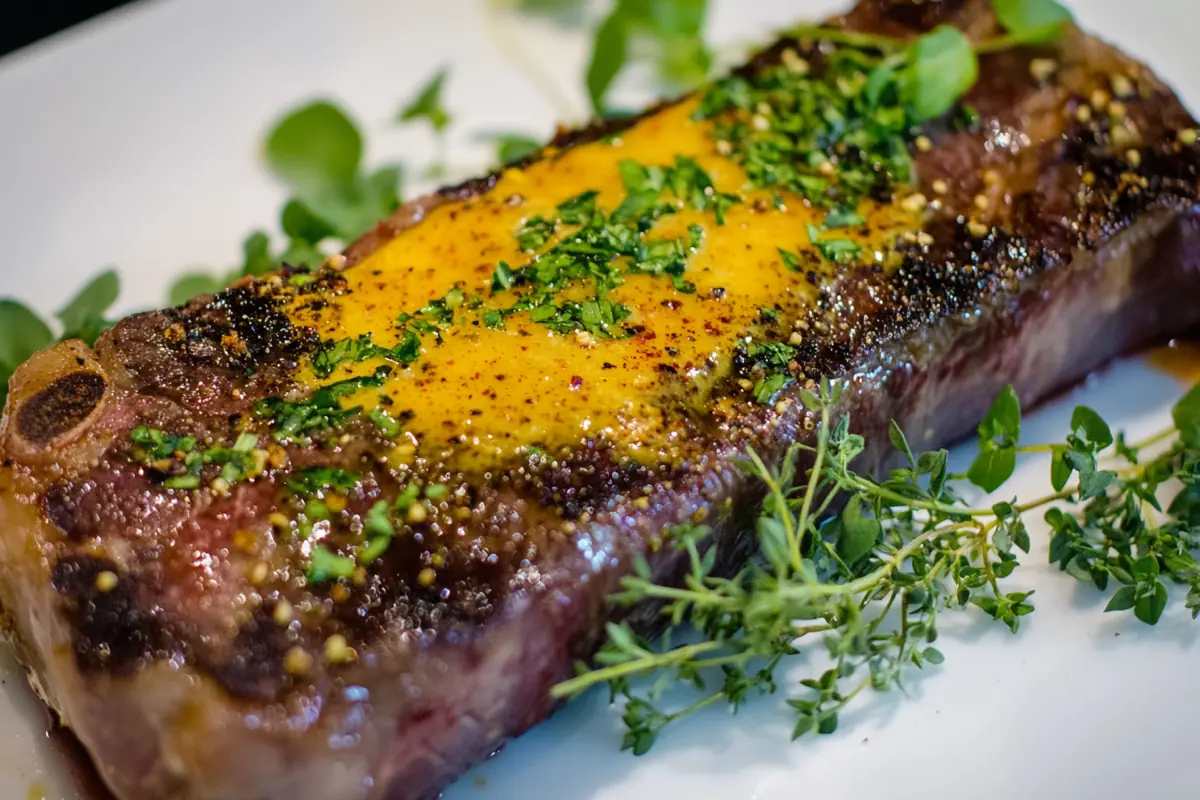When it comes to cooking steak, sous vide has become a popular method among chefs and home cooks alike. The precision and control it offers in achieving the perfect doneness make it stand out. But a common question arises: Should you put butter in sous vide steak? This article dives deep into the role of butter in sous vide cooking, exploring its benefits, how to incorporate it, and much more.
Table of Contents
Introduction to Sous Vide Cooking
Sous vide, which means “under vacuum” in French, involves sealing food in a bag and cooking it to a very precise temperature in a water bath. This technique allows for even cooking, ensuring that the meat retains its moisture and flavor. The process is simple: you vacuum-seal your steak, set the water bath to the desired temperature, and let it cook slowly.
What is Sous Vide?
Sous vide cooking has gained popularity for its ability to produce perfectly cooked dishes. By immersing food in water, it cooks gently and evenly, allowing for consistent results. This method eliminates the risk of overcooking, making it ideal for steak lovers.
Benefits of Sous Vide Cooking
The benefits of sous vide cooking are numerous. First, it allows for precise temperature control, so you can achieve your preferred doneness every time. Second, the low and slow cooking method enhances the flavor and tenderness of the steak. Finally, sous vide reduces the chances of drying out your meat, ensuring every bite is juicy and flavorful.
The Role of Butter in Sous Vide Steak
When considering whether to add butter to sous vide steak, it’s essential to understand its impact on flavor and texture. Butter can enhance the overall experience of your steak, making it richer and more indulgent.
Why Use Butter?
Adding butter in sous vide steak is not just about enhancing flavor; it also enriches the cooking process. Butter can help baste the meat while it cooks, adding moisture and flavor. Moreover, it contributes to a luscious mouthfeel, elevating your steak to gourmet levels.
How Butter Enhances Flavor
Butter carries and amplifies flavors, making it an ideal companion for steak. When combined with herbs and spices, it creates a delightful infusion. For instance, sous vide steak rosemary butter is a popular combination that adds aromatic notes, making your steak even more delicious. This infusion not only elevates the taste but also makes the dish visually appealing.
What to Put in Sous Vide Bag with Steak
To achieve the best results when cooking steak sous vide, knowing what to include in your sous vide bag is crucial. The right ingredients can enhance flavor, texture, and aroma.
Essential Ingredients for Sous Vide Steak
When preparing your sous vide bag, besides butter, consider adding ingredients like salt and pepper for seasoning. Additionally, you can include garlic, shallots, or even a splash of olive oil. These elements will complement the steak’s flavor and provide a well-rounded taste.
Herbs and Aromatics: Enhancing Your Steak
Herbs and aromatics play a significant role in enhancing the flavor of your sous vide steak. Fresh herbs like rosemary, thyme, and parsley can impart their unique flavors during the cooking process. Simply add a sprig or two into the bag with your steak. This simple step can elevate the dish from ordinary to extraordinary.

Butter in Sous Vide Bag Steak: Pros and Cons
Incorporating butter into the sous vide bag has its advantages and disadvantages. It’s essential to weigh these factors to determine if it’s the right choice for your cooking style.
Advantages of Adding Butter
One of the main benefits of adding butter in sous vide steak is the flavor boost. The richness of butter can transform a simple steak into a gourmet meal. Additionally, butter helps to keep the steak moist during the cooking process, enhancing the overall texture.
Moreover, butter can create a beautiful glaze when seared after cooking, adding an appetizing look to your presentation. The combination of flavors and textures elevates your dish, making it
Butter in Sous Vide Bag Steak: Pros and Cons
Adding butter in sous vide steak bag can enhance the cooking process, but it’s important to consider both the advantages and drawbacks. Understanding these factors can help you make an informed decision when preparing your next steak.
Advantages of Adding Butter
The primary advantage of using butter in your sous vide bag is the flavor enhancement it provides. Butter adds a rich, creamy taste that can elevate the overall experience of your steak. Here are a few key benefits of incorporating butter:
- Flavor Enrichment: Butter infuses your steak with a delectable richness, enhancing the overall taste profile. This is especially true when using flavored butter, such as garlic or herb-infused varieties.
- Moisture Retention: The fat in butter helps keep your steak moist and tender during the cooking process. This is crucial, as sous vide cooking is all about maintaining juiciness without drying out the meat.
- Seared Finish: When you finish your steak with a quick sear in a hot pan after sous vide cooking, the butter can create a beautiful, glossy crust. This adds both flavor and visual appeal to your dish.
Potential Drawbacks of Using Butter
While butter has its benefits, there are also some potential downsides to consider. Here are a couple of drawbacks:
- Increased Cooking Time: Adding butter can slightly increase the cooking time due to its density. However, this effect is minimal in the context of sous vide cooking.
- Saturation: If too much butter is added, it can overwhelm the natural flavors of the steak. It’s important to find a balance that enhances rather than masks the meat’s inherent taste.
Sous Vide Steak Rosemary Butter Recipe
One of the most popular ways to incorporate butter in sous vide steak is through a rosemary butter recipe. This combination not only enhances the flavor of the steak but also adds a delightful aroma.
Ingredients for Rosemary Butter
To make rosemary butter, you’ll need the following ingredients:
- 1 stick (1/2 cup) unsalted butter, softened
- 2 tablespoons fresh rosemary, finely chopped
- 2 cloves garlic, minced
- Salt and pepper to taste
You can adjust the quantities based on your taste preferences. This simple recipe is easy to prepare and can be made ahead of time.
Step-by-Step Process to Make Rosemary Butter
Creating rosemary butter is straightforward. Follow these steps:
Prepare the Ingredients: In a mixing bowl, combine the softened butter, chopped rosemary, minced garlic, salt, and pepper. Mix until well combined.
Shape the Butter: Place the mixture on a piece of parchment paper. Roll it into a log shape and twist the ends to seal. This makes it easy to slice later.
Chill: Refrigerate the butter for at least 30 minutes until it firms up. You can also freeze it for longer storage.
Use in Sous Vide Cooking: When you’re ready to cook your steak, slice a piece of the rosemary butter and place it in the sous vide bag with your steak.
Finish with a Sear: After cooking your steak sous vide, sear it in a hot pan, adding any remaining rosemary butter for an extra flavor boost.
Cooking Time and Temperature for Sous Vide Steak
Understanding the right cooking times and temperatures is crucial for achieving the perfect sous vide steak. Different cuts of steak require different settings to ensure optimal results.
Ideal Cooking Times for Different Cuts
Different cuts of steak have varying recommendations for cooking times. Here’s a general guideline:
- Filet Mignon: 1.5 to 3 hours at 130°F (54°C) for medium-rare.
- Ribeye: 2 to 4 hours at 131°F (55°C) for medium-rare.
- New York Strip: 1.5 to 2.5 hours at 130°F (54°C) for medium-rare.
- Sirloin: 1.5 to 3 hours at 130°F (54°C) for medium-rare.
These times ensure that your steak is cooked to perfection while remaining tender and juicy.
Recommended Temperatures for Sous Vide Steak
Choosing the right temperature is essential for achieving your desired doneness:
- Rare: 120°F (49°C)
- Medium-Rare: 130°F (54°C)
- Medium: 140°F (60°C)
- Medium-Well: 150°F (66°C)
- Well Done: 160°F (71°C)
By following these temperature guidelines, you’ll be able to create a delicious steak that meets your preference.
Does Butter Change the Cooking Time for Sous Vide Steak?
When you consider using butter in sous vide steak cooking, a common question arises: Does butter change the cooking time? Understanding how ingredients interact during the sous vide process is critical for achieving the best results.
Understanding Sous Vide Cooking Principles
Sous vide cooking is all about precision. The water bath heats food evenly, allowing it to cook at a consistent temperature over a set period. This method ensures that the steak cooks uniformly without the risk of overcooking.
When adding butter, it may slightly change the dynamics of heat transfer. However, in sous vide cooking, the difference is minimal. The primary cooking time is determined by the thickness of the steak and the target temperature rather than the addition of butter. Therefore, while butter may have a slight effect, it typically won’t require a significant adjustment in cooking time.
Impact of Butter on Cooking Time
Butter itself has a melting point around 90°F (32°C), so it will melt quickly once the sous vide bath reaches the desired temperature. Its presence won’t significantly alter the cooking duration.
In practice, if you are cooking a steak for, say, 2 hours at 130°F (54°C), adding butter won’t necessitate extending that time. Instead, focus on ensuring that your steak is at least 1.5 inches thick for the best results. This thickness allows the heat from the water bath to penetrate fully without altering the cooking time.
How Does Butter Affect the Texture of the Steak?
Butter does more than just enhance flavor; it can also impact the texture of your steak. Understanding this can help you make the most of your sous vide cooking experience.
The Science of Butter and Meat Fat
Butter is composed of milk fat, which adds richness and creaminess to dishes. When you cook steak sous vide with butter, the melting fat seeps into the meat, promoting a tender and juicy texture. The fat from the butter coats the steak, allowing it to retain moisture while cooking.
Moreover, the high-fat content in butter can help create a more luxurious mouthfeel. This is especially evident when butter is used in conjunction with other flavor-enhancing ingredients, such as herbs or garlic. These combinations can elevate the overall experience of your steak.
Texture Comparisons: With vs. Without Butter
To illustrate the difference, consider this: a steak cooked without butter may still be tender, but it might lack that rich, silky texture that butter provides. Conversely, a steak cooked with butter tends to be more succulent and flavorful.
- Without Butter: The steak may have a firmer texture with a more straightforward beef flavor.
- With Butter: The steak will likely be more tender, with a rich and creamy finish that enhances the overall dining experience.
In conclusion, using butter in sous vide steak not only improves flavor but also significantly enhances texture, making it a worthwhile addition.
Tips for Using Butter in Sous Vide Cooking
To maximize the benefits of using butter in sous vide steak preparation, consider these helpful tips. They can enhance your cooking experience and ensure the best results.
Best Practices for Adding Butter
Use Unsalted Butter: Opt for unsalted butter to control the seasoning of your steak better. This allows you to add salt to taste without overwhelming the dish.
Add Butter at the Right Time: While you can add butter before sealing your sous vide bag, consider also adding it after cooking for a final flavor boost. This technique can enhance the richness even further when you sear the steak.
Experiment with Flavor Infusions: Incorporate herbs, garlic, or spices into your butter to create a unique flavor profile. Consider experimenting with different combinations to find your favorite.
Common Mistakes to Avoid
Overusing Butter: While butter enhances flavor, adding too much can overpower the natural taste of the steak. A couple of tablespoons are usually sufficient.
Skipping the Sear: After cooking sous vide, always finish your steak with a quick sear. This step caramelizes the surface, adding a delicious crust that contrasts beautifully with the tender interior.
Not Monitoring Temperature: Ensure your sous vide water bath is set to the correct temperature before adding your steak. An inaccurate temperature can lead to inconsistent results.
By adhering to these tips, you can make the most of butter in sous vide steak preparation, enhancing both flavor and texture.

Conclusion: To Butter or Not to Butter?
When it comes to sous vide steak, the question of whether to use butter is one that can enhance your culinary experience. The benefits of adding butter, from flavor enrichment to improved texture, are compelling reasons to consider its inclusion in your cooking process.
Summary of Key Points
- Flavor Enhancement: Butter adds richness and depth to your steak.
- Moisture Retention: It helps keep the steak juicy during cooking.
- Texture Improvement: The creamy mouthfeel of butter elevates the overall experience.
Final Thoughts on Sous Vide Steak and Butter
In conclusion, if you’re looking to take your sous vide steak to the next level, adding butter is a fantastic choice. Not only does it enhance the flavor and texture, but it also allows for creative combinations with herbs and spices. So, when you prepare your next steak, consider the role of butter and enjoy the gourmet experience it brings to your plate.
FAQ
As you explore the benefits of using butter in sous vide steak, several questions often arise. Below are answers to some of the most common queries related to butter in sous vide cooking.
Can I Use Unsalted Butter in Sous Vide Cooking?
Yes, using unsalted butter is highly recommended for sous vide cooking. Unsalted butter allows you to control the seasoning of your dish better. This way, you can add salt to your steak according to your taste preferences, ensuring the flavors are balanced. Moreover, you can experiment with different seasonings without the risk of over-salting your dish.
What Are the Best Types of Butter in Sous Vide Steak?
The best types of butter in sous vide steak include:
– Unsalted Butter: This is the preferred choice for many cooks, allowing for better control over seasoning.
– Flavored Butters: Herb-infused or garlic butter can add additional flavor dimensions to your steak.
– Grass-Fed Butter: This variety often has a richer flavor and higher omega-3 fatty acids, making it a healthier option.
Using a combination of these types can elevate the flavor of your steak significantly.
Does Butter Change the Cooking Time for Sous Vide Steak?
No, adding butter does not significantly change the cooking time for sous vide steak. The cooking time primarily depends on the thickness of the steak and the desired doneness. Butter melts quickly in the sous vide water bath, so it won’t require you to adjust cooking times. Aim for the appropriate time based on your steak cut and thickness.
How Does Butter Affect the Texture of the Steak?
Butter positively influences the texture of the steak. When used in sous vide cooking, the melting fat from the butter coats the meat, keeping it moist and tender. This enhances the overall mouthfeel, making the steak richer and creamier. The difference is noticeable when comparing a steak cooked with butter to one cooked without; the former tends to have a more luxurious texture.




